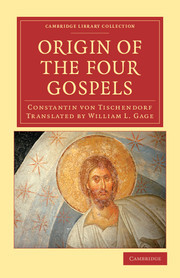Description
Origin of the Four Gospels
Cambridge Library Collection - Biblical Studies Series
Author: Tischendorf Constantin von
The 1868 translation of the fourth German edition of this polemical work by the pioneering but controversial biblical textual scholar.
Language: English
Subject for Origin of the Four Gospels:
32.87 €
In Print (Delivery period: 14 days).
Add to cart
Publication date: 01-2012
Support: Print on demand
Support: Print on demand
Description
/li>Contents
/li>
Constantin von Tischendorf (1815?74) was a pioneering textual scholar of the New Testament, who discovered and transcribed early manuscripts, notably the Codex Sinaiticus, his acquisition of which provoked long-lasting controversies. The original German edition of this book appeared in 1865, and sold 2,000 copies in three weeks; this English translation (1868) was based on the improved and expanded fourth German edition (1866). In it, Tischendorf applies his enormous knowledge of early Christian literature and the oldest Latin, Greek and Syriac gospel manuscripts to the question of the date of the canonical gospel texts, which, he argues, had been established by the end of the first century. Parts of the book are highly polemical, with Tischendorf referring to 'the Tübingen fantasy-builder and the Parisian caricaturist' in his attempt to refute contemporary theories about the person of Jesus. Nevertheless his translator engagingly describes him as a 'great and genial' scholar.
Translator's preface; Author's preface; 1. The Gospels our sources for the life of Jesus; 2. Importance of the historical witnesses for the Gospels; 3. Evidence from the last decades of the second century; 4. Irenaeus, Tertullian, Clemens of Alexandria, the canon of Muratori, the oldest Latin and Syriac translation; 5. Shortly before Irenaeus; 6. First and fourth quarters of the second century; 7. Justin and the Epistle to Diognetus; 8. The Gospel of the Hebrews; 9. The literature of heresy before and in the middle of the second century; 10. Marcion; 11. Montanism and the Alogians; 12. Celsus vs. Christianity; 13. The New Testament apocryphal literature; 14. The pseudo-Clementines; 15. Barnabas; 16. When and how to come to a decision regarding the four Gospels; 17. The testimony of Papias; 18. New Testament criticism; 19. Its evidence as to a lost form of Matthew and Mark; 20. The text of the second century presupposes a full history of the canon, and gives evidence of its existence at about the close of the first century; 21. Evidence omitted; 22. Misunderstandings and hypotheses regarding the Gospel of John; 23. Concluding remarks.
© 2024 LAVOISIER S.A.S.




